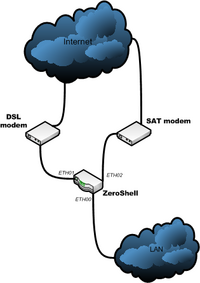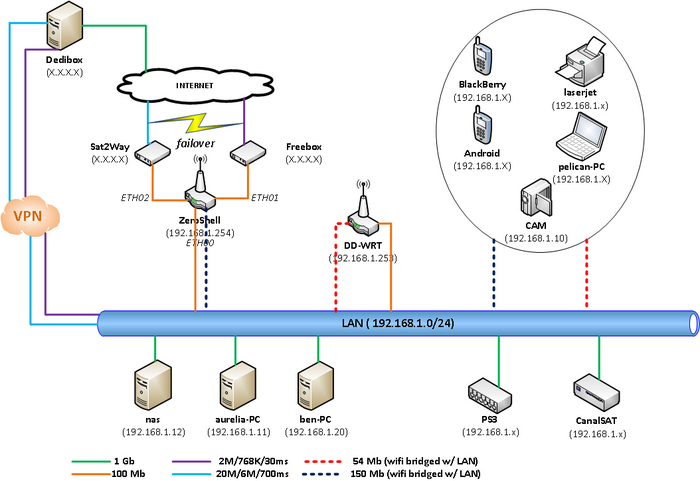Table des matières
DSL and satellite links aggregation
The purpose of this document is to explain how to aggregate a DSL link (low latency, low bandwidth) with a satellite link (high latency, high bandwidth) to get the best parts of both solutions. Actually it's not a real “aggregation” method but it's rather a manual balacing depending on outgoing traffic.
Context
Living far away from the city and thus far away from a DSLAM, the DSL link I'm connected to doesn't allow decent bandwidth (1.5 Mbits/768 Kbits) but the latency is fine (∼ 30ms). Current satellite internet rate plans can reach 20 Mbits/6 Mbits with a round latency of 700ms.
Why more bandwidth ?
- Having severals computers or devices is painful in case of software upgrades (occur pretty often)
- Overall bandwidth is crawled when a computer/device is downloading
- Sending files takes millions of years (remote backups, emails, etc)
- VOD with some TV related devices require a lot of bandwidth (> 5Mbits)
Why keeping a DSL link ?
- Online gaming (MMORPG, FPS) needs a low latency
- Vital network services (like DNS) run smoothly with a low latency. Performing DNS resolution with a DSL link should improve matters
- Interactive services such as SSH and VPN can turn you mad with a too high latency but work great with a DSL link
Having 2 links allow to use failover in case one link is failing.
Cons
- Price is high (one DSL and one satellite subscription)
- Setting a parabola up is painful
Used software
To achieve this we use ZeroShell. It has tons of functionalities and especially handles multi WAN interfaces (with load balancing, failover and manual balancing). It's based on Linux and runs on many devices (PCs, Alix/Soekris boards, etc). Although it's live CD based profiles and parameters can be saved on hard drive, usb devices, CF/SD cards, etc. Specific hardware images are also available for download. A recent linux distro can do the job but you need to be familiar with advanced iptables configuration, routing, traffic classification, etc. ZeroShell makes life easier.
A Web GUI is available to perform all tasks (except Wireless). A console or SSH access is available anyway.
Used hardware
- Alix boards 2D3 with 3 LAN interfaces and 1 mini PCI wireless adapter
- 1 dsl modem (acting as a bridge and providing a WAN ip, let's say WAN_IP1 for later use)
- 1 satellite modem (acting as a bridge and providing a WAN ip, let's say WAN_IP2 for later use)
- At least one switch to connect the router to the LAN
⇒ ZeroShell supports PPPoE, 3G modems, etc

